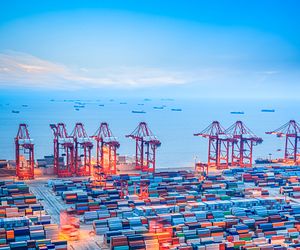China’s dragon economy has slowed, reflecting a structural shift toward a service-based economy and, to some extent, bearish sentiment. While to some degree this has been intentional, China’s slowdown has had serious knock-on effects on the global economy through commodities, imports, and real investment channels.
China has been purchasing fewer commodities, seriously dampening the global commodities market. The country made up for a falloff in global demand for commodities after the global crisis hit Europe and the U.S., consuming a whopping half of commonly used metals such as steel and copper, but a Chinese economic slowdown now means falling demand for steel, iron ore, and copper, and hence falling prices. What is more, commodities-exporting countries ran current account surpluses as China boomed, purchasing government bonds with the surplus. The deficit resulting from a decline in commodities demand has led to a consequent decrease in government bond purchases from these countries. Decline in commodity demand has had significant repercussions for commodity-dependent economies such as Sierra Leone and Mongolia, as well as commodity-intensive exporting nations in Latin America, and Australia.
China has also faced a slowdown in year-on-year growth in imports of goods and services. Its imports of commodities certainly have declined as discussed above, along with imports of certain categories of industrial goods. The countries most dependent on exporting a variety of goods to China include Australia, New Zealand, and South Korea. Since China is a large market for many economies, nations around the world will be affected by the China slowdown. These include Indonesia, Malaysia, Singapore, Brazil, Russia, Thailand, Germany, the U.S., and others.
Finally, China’s declining growth has led to mixed results in global real estate markets. In Australia, the demise of the commodities boom fed by China’s fixed asset investment frenzy has led to real estate market collapses in some locations as prospective domestic home buyers have smaller incomes with which to purchase homes. Chinese demand for properties in Sydney and Melbourne has also taken a hit. In the United States, while states like California have experienced a decline in home purchases by Chinese buyers, other locations such as Manhattan in New York have undergone a surge in real estate investment as Chinese capital has left the country, searching for more profitable investments.
Given China’s slowing growth trajectory, it seems unlikely that it will be devouring massive quantities of commodities going forward, although imports in other sectors may pick up as citizens are encouraged to consume more. Already, food imports are on the rise, especially for meat and dairy products. China’s imports of soybeans, grains, oils, and cotton are also at relatively high levels. Still, the implications of China’s intended long-term slowdown are that the rest of the world will have to adjust to a trading partner less hungry for commodities, some categories of industrial goods, and select real estate markets. China’s changing economic landscape may result in more consumer-oriented demand for goods and more physical and human-capital intensive valued-added production. Fortunately, China’s transition is necessarily slow, and the rest of the world will have time to adjust as the nation changes tastes and preferences, production processes, and its overall global economic role.

































